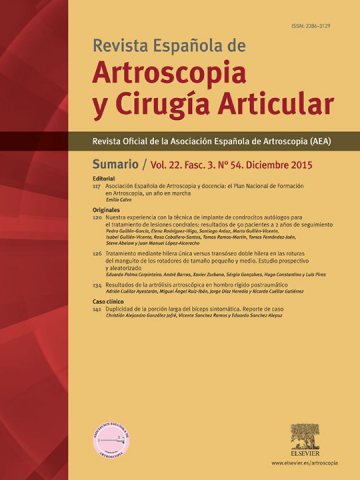Resumen:
Objetivo
Evaluar los resultados clínicos en pacientes con lesiones condrales en rodilla y tobillo, a los que se les ha realizado implante de condrocitos autólogos en membrana (MACI). Se han incluido 150 pacientes tratados con MACI (siempre por el mismo equipo quirúrgico) durante los años 2002-2007.
Métodos
En todos los casos se tomó una biopsia de cartílago para utilizarla como fuente para el cultivo celular mientras se evaluaba la lesión condral por artroscopia. El implante celular se realizó por artroscopia en 53 casos, mientras que en el resto fue por cirugía abierta. Los pacientes se evaluaron siguiendo un protocolo clínico interno. En 50 pacientes se realizó seguimiento de los resultados durante un periodo medio de 2 años. En 5 pacientes se realizó una biopsia de second look a los 2 años de seguimiento.
Resultados
En el 89% de los pacientes sin cirugías previas y en un 66% de los restantes, los resultados fueron buenos/excelentes en referencia al dolor y la movilidad; la mayoría de ellos pudieron retomar su actividad física previa, incluyendo deporte profesional. El análisis histológico de las 5 biopsias mostró que el tejido neoformado era cartílago tipo hialino, pero con menos celularidad y subjetivamente más blando que el cartílago hialino normal.
Conclusión
La técnica artroscópica del MACI es un procedimiento prometedor para el tratamiento de las lesiones condrales y osteocondrales de rodilla y tobillo, aunque el resultado histológico evidencia que el aumento de células proporcionaría todavía resultados mejores.
Nivel de evidencia
Nivel III.
Relevancia clínica
La importancia de este estudio radica en que se presenta un gran número de casos de pacientes con lesiones condrales tratados con MACI, muchos de ellos con implante mediante artroscopia. En este estudio se comprueba que el tratamiento con MACI proporciona buenos resultados.
Abstract:
Aim
The aim of this work was to evaluate the clinical results of the matrix-induced autologous chondrocyte implantation (MACI) technique on chondral defects of the knee and ankle. A study was conducted on 150 patients treated with MACI (performed by the same team of surgeons in all cases) during 2002-2007.
Methods
The lesion was evaluated by arthroscopy, and a cartilage biopsy was taken. The cellular implant was performed by arthroscopy in 53 patients, and by open surgery in the remaining cases. The results were measured following an in-house clinical protocol. Data corresponding to a mean follow-up period of 24 months were available in 50 out of the 150 implanted patients. Histological studies were performed in a second biopsy taken by arthroscopy in 5 patients 2 years after cell implantation.
Results
In 89% of patients without previous surgeries, and in 66% of patients with previous surgeries, the results were good or excellent for pain and motion, and most of them were able to return to their previous physical activities, including professional sport. Histological studies performed on a second biopsy showed that the new tissue is hyaline-like cartilage with lower cell numbers and subjectively softer than normal cartilage.
Conclusion
Arthroscopic MACI is a promising procedure to treat chondral lesions in the knee and ankle, although the histological analysis suggests that increasing cellular dosage would improve the results of the technique.
Level of evidence
Level III.
Clinical relevance
The importance of this study is that it presents an increased number of patients with chondral lesion treated with MACI. A high number of these patients were treated with arthroscopic MACI. In the present study it is shown that the treatment gives good results.
Keywords:
Autologous chondrocyte implantation
Collagen membrane
Arthroscopic Matrix-induced autologous chondrocytes implantation
Chondrocyte culture
Cartilage repair




